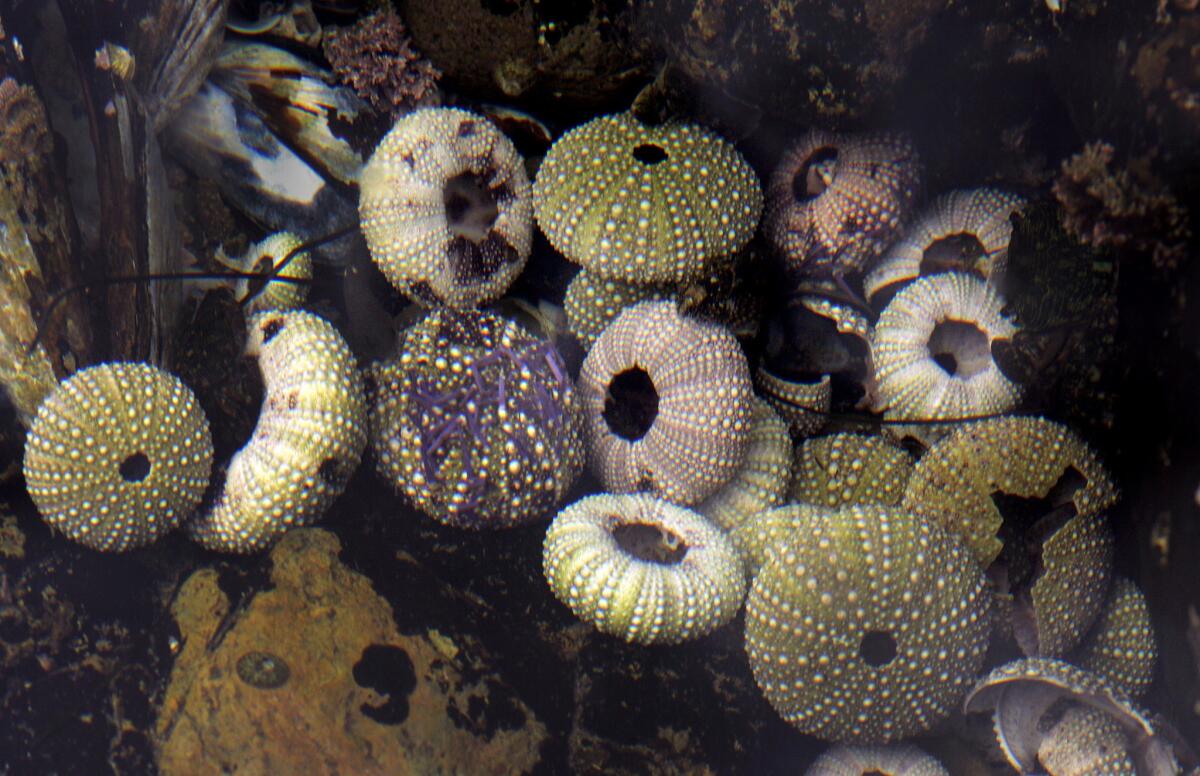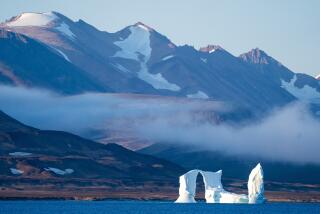Oceans might take 1,000 years to recover from climate change, study suggests

Sea urchins disappeared for thousands of years during ancient warming periods that could be a model of future climate change, a new study shows. Here, the shells of modern sea urchins lie in a tide pool in Corona del Mar.
- Share via
Naturally occurring climate change lowered oxygen levels in the deep ocean, decimating a broad spectrum of seafloor life that took some 1,000 years to recover, according to a study that offers a potential window into the effects of modern warming.
Earth’s recovery from the last glacial period, in fact, was slower and more brutal than previously thought, according to the study, published online Monday in the journal Proceedings of the National Academy of Sciences.
Researchers deciphered that plotline from a 30-foot core of sea sediments drilled from the Santa Barbara Basin containing more than 5,000 fossils spanning nearly 13,000 years.
“The recovery does not happen on a century scale; it’s a commitment to a millennial-scale recovery,” said Sarah Moffitt, a marine ecologist at UC Davis’ Bodega Marine Laboratory and lead author of the study. “If we see dramatic oxygen loss in the deep sea in my lifetime, we will not see a recovery of that for many hundreds of years, if not thousands or more.”
Studies already have chronicled declines in dissolved oxygen in some areas of Earth’s oceans. Such hypoxic conditions can expand when ocean temperatures rise and cycles that carry oxygen to deeper areas are interrupted.
As North American glaciers retreated during a warming period 14,700 years ago, an oxygen-sensitive community of seafloor invertebrates that included sea stars, urchins, clams and snails nearly vanished from the fossil record within about 130 years, the researchers found.
“We found incredible sensitivity across all of these taxonomic groups, across organisms that you would recognize, that you could hold in your hand, organisms that build and create ecosystems that are really fundamental to the way ecosystems function,” Moffitt said. “They were just dramatically wiped out by the abrupt loss of oxygen.”
That highly diverse community soon was replaced with a relatively narrow suite of bizarre and extreme organisms similar to those found near deep-ocean vents and methane seeps in modern oceans, Moffitt said.
Evidence of that transition was confined to such a narrow band of sediments that the turnover could have been “nearly instantaneous,” the study concluded.
Then, beginning around 13,500 years ago, the seafloor community began a slow recovery with the rise of grazers that fed on bacterial mats. Recovery eventually was driven by a fluctuation back toward glaciation during the Younger Dryas period, a cooling sometimes called the Big Freeze.
“The biological community takes 1,000 years to truly recover to the same ecological level of functioning,” Moffitt said. “And the community progresses through really interesting and bizarre states before it recovers the kind of biodiversity that was seen prior to the warming.”
That relatively brief freeze also ended abruptly around 11,700 years ago, virtually wiping out all the seafloor metazoans, the study found. They were gone within 170 years and did not appear again for more than 4,000 years, according to the study.
The climate changes chronicled in the study arose from natural cycles involving Earth’s orbit of the sun, and the oxygen declines that ensued were more extreme than those that have occurred in modern times, the study noted.
Still, the abrupt fluctuations offer a glimpse at the duration of the effects of climate change driven by human activity pumping more planet-warming gases into Earth’s atmosphere, Moffitt said.
“What this shows us is that there are major biomes on this planet that are on the table, that are on the chopping block for a future of abrupt climate warming and unchecked greenhouse gas emissions,” Moffitt said. “We as a society and civilization have to come to terms with the things that we are going to sacrifice if we do not reduce our greenhouse gas footprint.”
Follow me on Twitter: @LATsciguy







